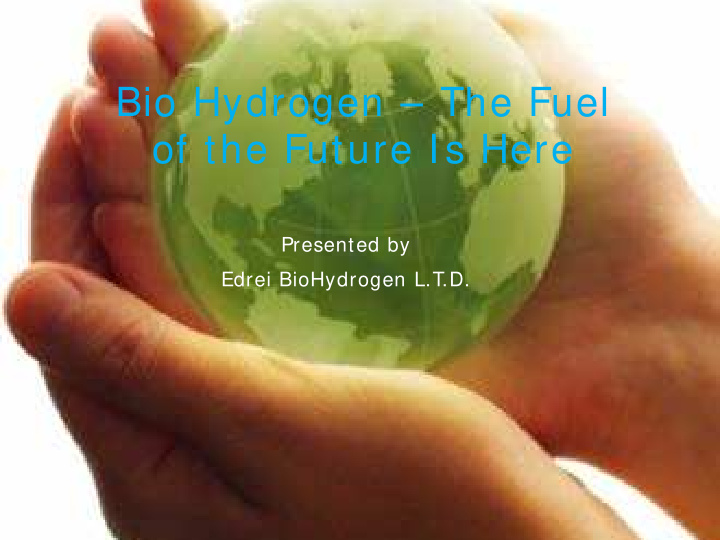



Bio Hydrogen – The Fuel of the Future Is Here Presented by Edrei BioHydrogen L.T.D.
Why Hydrogen? 1. We are living in a world where our natural fuel resources are degrading. 2. Hydrogen is one of the most common elements on earth and it is in water. 3. Hydrogen holds more energy than fossil fuel. Burning one gram of gasoline produces 11,000 calories, as to 30,000 calories produced by burning one gram of hydrogen. 4. The only by product when burning hydrogen is water. 5. Hydrogen that is produced from water splitting is a renewable energy.
Hydrogen Market Today The market value of hydrogen in 2011 was 87.5 billion USD and the estimated market value of hydrogen in 2016 is 118 billion USD.
The Use of Hydrogen Today Fuel refinery Ammonia industry Fertilizers industry Food industry Electronic components Rocket fuel and space shuttles
Why there is no use of hydrogen as a source of energy? Answ er: The production and storage cost of hydrogen is too high.
The Objective: Finding a new method to produce hydrogen at a cost of 2 .6 0 $ / Kg which will enable the use of hydrogen as a source of energy. This is the target cost of hydrogen production that was determined by USDOE in order to use hydrogen as a new source of energy. The lowest production cost of Hydrogen is from natural gas and it is 3.5-4.5 $/ Kg which is too high for using H2 as a source of energy
The way to do it: Hydrogen production by algae! Today there are more than 150 laboratories in the world that are conducting researches in order to achieve that objective.
The economical barrier: Hydrogen production by alga is too slow. Professor Anastasios Melis Berkeley University:
The breakthrough of EDREI BioHydrogen After a research of 5 years we developed a method that enhances hydrogen production by the algae 4.5 fold than the usual production rate, and our goal is to enhance hydrogen production rate by 25 fold.
Lab Results Hydrogen production Total volume of in the first 14 hours hydrogen
Comparison of hydrogen production rate with and without bacteria Algal bacterial co-culture Algae alone
According to lab results, we enhanced hydrogen production and reached more than 60% of the theoretical maximum Our projection is that hydrogen production rate using our method and developing a cost effective bioreactor could be enhanced by 5 fold than what we achieved so far, and the production cost of hydrogen would be about 0 .8 9 $ / Kg The budget needed to develop a prototype is 3,000,000$ for 3 years of development.
Projected production Costs 140000000 18 16 120000000 14 100000000 12 $/ kg H2 80000000 10 $ 8 60000000 6 40000000 4 20000000 2 Capex 0 0 Opex 1 2 3 4 5 6 7 8 9 10 I m provem ent in H2 Production Rate $/ kg
Responses from the academic world Dear Jacob: I was informed that you may have develop a microalgal hydrogen production process that produces substantially more than the 2-3 mL H2 per L culture per h previously reported. I am not privy to the specifics of your discovery, nevertheless, I wished to congratulate you for your achievement. Please let me know if I could be of any help in your efforts. Kind regards, Tasios Melis
, Dear Prof. Melis . Thank you for your kind words I have developed a process of hydrogen production that let the algae Chlamydomonas reinhardtii produce molecular hydrogen at an average rate of 11.2 ml. H2 per 1.0 Liter of culture per 1.0 hour, during the first 14 hours of hydrogen . production Lag time from the beginning of sulfur deprivation until . hydrogen production phase was reduced to 17 hours I am working with the collaboration of Prof. Gadi Schuster from the Israeli Technion, and with Dr. Yoram Gerchman . from Haifa University - Oranim college At this stage I established a startup company, and we are looking for funds in order to continue the research in order to build a prototype based on the lab scaled model after . optimization I would be glad if you will accept collaborating with us in our research, and help in our efforts to raise funds for that . purpose , Best regards Jacob . Edrei Jacob C.E.O . EDREI BioHydrogen L.T.D
Dear Jacob: Thank you for the introduction to the improvements you achieved. ~ 11 ml H2 per L culture per h, even if it is only during the first 14 hours of hydrogen production, is im pressive indeed! I'd be pleased to help your efforts both to further improve and also to commercialize your process. Kind regards, Tasios
Special thanks to the people that helped us in our efforts: To professor Gadi Schuster from The Israeli Technion. To professor Oded Beja from The Israeli Technion. To professor Uri Pick from Weizmann Institute. To professor Michal Shapira from Ben Gurion University.
Recommend
More recommend